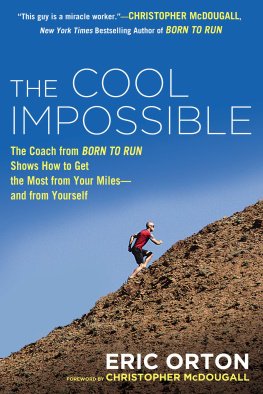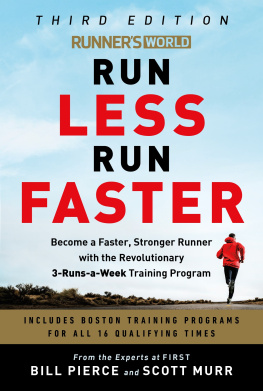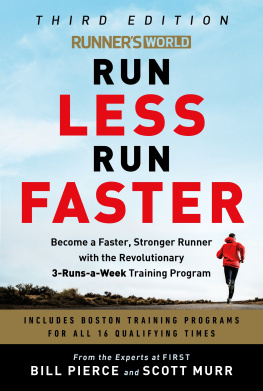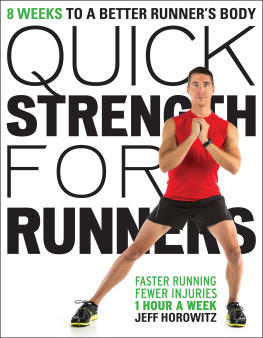
CONTENTS
STRENGTH TRAINING FOR RUNNERS: A PRIMER
GETTING STARTED
THE EXERCISES
THE WORKOUTS
TAKING IT ON THE ROAD
A LIFETIME OF FITNESS
INTRODUCTION

Once upon a time, about twenty years ago, to be precise, runners believed that they didnt have to do anything but run.
AMBY BURFOOT
1968 Boston Marathon Champion and former editor of Runners World magazine
Lets start with a bit of honesty: Not all runners love strength training. If you are like most runners, you would rather lace up your trainers and spend time out on a trail or road than work out in a gym. I understand that. You didnt become a runner to spend more time indoors. There is a whole world of routes to explore when you are out on a run, and none of them pass through a weight room.
But you picked up this book anyway. More likely than not, you did so because you realize that doing nothing but running is not working out so well for you.
Maybe this realization came to you during a layoff from running caused by an injury. Estimates of the rate of injury for runners vary widely, but it may be as high as 80 percent for all runners in a given year and 80 percent for each individual runner over the course of his or her lifetime.
Each of these injuries comes at a physical, emotional, and financial cost. An injury may result in a layoff from running ranging from a week to several months and may require X-rays and MRIs, visits to various physicians, and physical therapy.
The anger, frustration, and sense of helplessness that often accompany these injuries are harder to measure. Injured runners may feel betrayed by their own bodies and isolated from their network of running friends. A long layoff may leave runners wondering if being injured and limited is their new permanent reality. These are hard times for such runners. Frustration often leads them to spend thousands of dollars on products and treatments that often promise quick cures but that rarely deliver results.
I remember one period when I was dealing with a debilitating foot problem. After spending six months visiting different specialists and undergoing various therapies, I realized that had a doctor recommended smearing peanut butter on my foot to speed healing, I would have done it. In fact, I would have smeared peanut butter over my entire body just to be doubly sure! I suspect that I am not the only runner who would have been willing to do that. Perhaps you have felt that way yourself.
Or maybe you picked up this book because you have read about how strength training can actually help prevent injuries and improve your running. Perhaps you are even doing some strength training already, but you suspect that you could do a better job if you knew a bit more about it.
Whatever led you to be interested in strength training, you have picked up this book, and thats a good thing. Because all those articles and bits of advice were right: Strength trainingthe right kind of strength trainingwill make you a stronger, more injury-resistant runner.
Examining the Simple Act of Running
Of all the worlds great sports, running is perhaps the simplest. No referee is needed to administer complicated rules and no scorer is needed to tabulate points. There are no formulas for figuring out who gets into the playoffs because there are no playoffs.
Running generally requires very little equipment, and no dedicated field or court is absolutely necessary. Almost anyone can run almost anywhere, and running is something most people learned to do when they were only two or three years old.
Even racing is breathtakingly simple. All the racers line up and at the signal run from here to there as fast as they can.
And yet the act of running is enormously complicated. It requires the balancing of the entire body as it rotates and hurtles through space, the flexion and extension of a long list of joints, and the timed contraction and release of muscles from head to toe.
Consider this: The liftoff phase of your running motion, when you raise up your leg, is itself a complicated choreography of movement. It requires the contraction of the hip flexor muscles along your lower trunk, as well as of the anterior tibialis muscle of your shin and the leg biceps muscles of your rear thigh. Together, these actions produce flexion of your hip and knee joints while positioning your foot in a toes-up position.
For all this to take place, the opposing muscle groups must relax and lengthen in an ordered sequence. The quadriceps muscles in your front thigh, the soleus and gastrocnemius muscles in your calf, and the gluteus maximus muscle in your backside must all engage in a controlled extension.
And that is not all. You are not doing all these movements from a solid, stable position: You are lunging upward and forward as you are getting airborne. As you do this, your central nervous system avoids crashes, falls, sprains, strains, and other calamities by engaging a multitude of other muscles, large and small, to help you maintain balance in space, in a process called proprioception.
Ready for more? While all these actions are taking place, your brain is ordering your arms to swing in opposition to the movement of your legs, which helps you maintain alignment along your central axis. If you are running on uneven terrain, such as on an off-road trail, your brain is also ordering quick adjustments with each step to keep you vertical. Ligaments and tendons heave and pull while small muscles contract, hold, and then release. Elsewhere, your body is busy regulating heat, supplying oxygen and fuel, and removing waste products.
All this happens in the simple action of running a single step.
If we were required to consciously control all these actions, we would be hard-pressed to even get out of bed in the morning. And yet with the assistance of our central nervous systems and our networks of muscles, we do. Every day. We learn to run, and many of us start running for hours and then run in long-distance races. But few of us think about the choreography of running and what is required to make it work.
Why is this all so complicated? Because running is an inherently unbalanced activity. It comprises a series of controlled forward falls. And during the process of running, you are never balanced equally on your two legs. Instead, you are on one foot, then up in the air, and then on the other foot. To fully understand these movements and how strength training relates to running, we need to delve into the biomechanics of running.
Running is, of course, primarily about moving forward. As opposed to other sports, such as basketball or tennis, that involve moving in multiple directions, running basically occurs in a single plane of motion: what exercise physiologists call the sagittal plane, which divides your body front to back, producing two mirrored images. When you are running, everything moves forward and backward on this plane: One of your arms and the opposite leg swing forward as the opposite two swing backward and vice versa.
Now the really challenging aspect of running occurs to you laterally as you run. When you land on one foot, you are in a very unstable position. And what happens at that moment can greatly affect your running and your odds of getting injured.
Try a quick demonstration. Stand on one foot. Now try holding that position for 10 seconds, but with your eyes closed.
Next page











